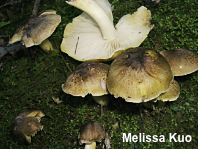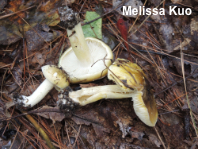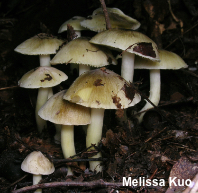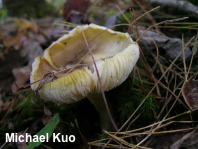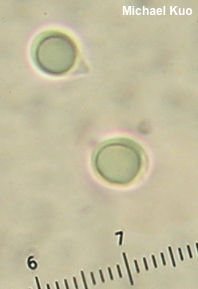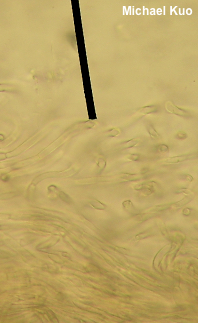| Major Groups > Gilled Mushrooms > Pale-Spored > Tricholoma > Tricholoma species 03 |

|
Tricholoma species 03: viridilutescens? [ Basidiomycota > Agaricales > Tricholomataceae > Tricholoma . . . ] by Michael Kuo This Tricholoma will be featured in your North American field guide (including one written by me) as "Tricholoma sejunctum." However, the true Tricholoma sejunctum, it turns out, is associated with hardwoods in Europe and possibly in North America (see the linked page for more information), while the species or species group featured here is associated with conifers. Like Tricholoma sejunctum it is greenish yellow or yellow-green, with darker appressed fibrils radiating from the center of the cap, along with white gills that develop yellow shades, and a mealy odor—but the radiating fibrils are darker and more contrasting than those of Tricholoma sejunctum, and the odor is generally not as strong. In their treatment of northern Europe's tricholomas, Christensen and Heilmann-Clausen (2013) note that "[r]eports of T. sejunctum from North America in Bessette et al. (2013) might well represent T. viridilutescens." The Bessette publication is Tricholomas of North America (2013), and it designates "conifers, especially pine and spruce" as the association for Tricholoma sejunctum; the accompanying photos feature pine and spruce needles, and caps with strongly contrasting fibrils. Is the hunch of Christensen and Heilmann-Clausen correct? Perhaps. For now, however, the most reasonable strategy IMHO is to separate our continent's conifer- and hardwood-associated sejunctum-like species (or groups of species), and wait for a thorough, DNA-informed study of many North American collections. Don't hold your breath, though; these things usually take forever . . . Description: Ecology: Mycorrhizal with conifers; growing scattered or gregariously; late summer and fall; distribution uncertain. The illustrated and described collections are from Kentucky and Michigan. Cap: 3.5–6 cm; convex with a slightly inrolled margin when young, becoming broadly convex when mature; sticky when fresh but soon dry; covered with innate, appressed, radiating, dark brown to dark gray or nearly black fibrils over a greenish yellow to yellow-green ground; the margin not becoming lined. Gills: Attached to the stem by a notch; close; short-gills frequent; whitish when young, developing yellow shades toward the margin of the cap or overall. Stem: 3–9 cm long; 1–1.5 cm thick; more or less equal; bald or finely silky; whitish to yellowish; basal mycelium white. Flesh: White; unchanging when sliced. Odor and Taste: Usually mealy, but sometimes only faintly so. Chemical Reactions: KOH negative on cap surface. Spore Print: White. Microscopic Features: Spores 5–7 x 4–5.5 µm; ellipsoid to broadly ellipsoid; apiculate; smooth; inamyloid; hyaline in KOH. Basidia 4-sterigmate. Pleurocystidia not found. Cheilocystidia not found. Pileipellis an ixocutis of cylindric elements 3–6 µm wide, smooth and hyaline in KOH, or brownish and encrusted (fibrils). Clamp connections not found. REFERENCES: (Bessette et al., 2013; Christensen & Heilmann-Clausen, 2013.) Herb. Kuo: 10160408, 09241103, 09281909. This site contains no information about the edibility or toxicity of mushrooms. |
© MushroomExpert.Com |
|
Cite this page as: Kuo, M. (2019, September). Tricholoma species 03: viridilutescens? Retrieved from the MushroomExpert.Com Web site: http://www.mushroomexpert.com/tricholoma_sp_03.html |
